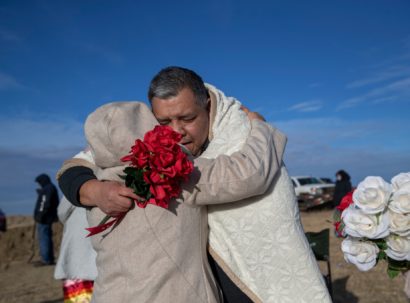Past, Present Standing Rock Chairmen Discuss Wind Farm Progress
By AMY R. SISK
The Standing Rock Sioux Tribe is moving toward building a wind farm on its reservation in south-central North Dakota, with efforts being made to avoid sacred sites as tribal officials pinpoint locations for each turbine.
The tribe will soon put up “met towers,” which provide data such as wind speed during project development, said Joseph McNeil, general manager of SAGE Development Authority. SAGE stands for “Strategic Advancement Goals for the Environment” and recently was formed by Standing Rock as a public power authority.
SAGE is planning to put up the turbines along the Porcupine Hills, a windy stretch of Badlands.
The project, known as Anpetu Wi or “the breaking of the new day” in Lakota, is the most advanced effort Standing Rock has made toward bringing utility-scale wind power to the reservation. Three tribal chairmen — past and present — spoke about the work Thursday on a Zoom call watched by supporters and students in various Standing Rock schools.
“The former chairmen all support it one way or another,” said Chairman Mike Faith, the tribe’s current leader. “It’s not without ups and downs. We’ll run into roadblocks here and there.”
The idea to build a wind farm on Standing Rock has been around for years, but one significant barrier has been a lack of transmission lines to transport the power. A lot of lines in North Dakota have been full because they already carry coal power, said Ron His Horse is Thunder, who served as chairman from 2005-09.
In recent years, transmission has been at capacity across the Upper Great Plains amid a boom in renewable power. The issue plagues some wind developers who propose projects that end up facing insurmountably costly upgrades to connect to the grid.
Furthermore, developers who have pitched putting a wind farm on Standing Rock have proposed partnerships that “were really about profit-making for that company,” rather than helping bring revenue to the tribe, His Horse is Thunder said.
“In the past, we couldn’t always get Tribal Council to agree that that’s where we should expend our resources and our energy,” he said.
Officials with SAGE hope that with the right approach, including the work the tribe is putting into the early stages of the project, they can attract a developer to bring the Anpetu Wi wind farm to fruition in a way that best benefits the tribe.
Dave Archambault, chairman from 2013-17, said past proposals would have involved a wind company signing a lease with the tribe for the use of its land. While that could have meant as much as $800,000 in revenue to the tribe, it paled in comparison to $15-$20 million the company would make annually from the project, he said.
“We need to start looking at how we could be owners of projects, not the lessors of our land, and get the lion’s share,” he said. “It may take time to evolve into (becoming) the 100% owner of a project.”
The chairmen envision revenue from the wind project helping fund future tribal projects that have nothing to do with electricity. Creating a credit union on the reservation and building housing are among some of their ideas.
“Moving in this direction really helps the (Standing Rock) Nation become self-sustainable,” Archambault said.
Standing Rock has organized a crowdfunding effort at www.anpetuwi.com to complete some of the early stages of the project. The tribe is working with several advisers, including LIATI Capital, Connexus Capital and Hometown Connections, and a number of funding partners.
You Might Also Like
On January 12, 2021, Jack Healy at The New York Times reported on the devastating toll that the Coronavirus has taken on the Standing Rock Sioux Tribe and other Indigenous nations in the U.S.
The catastrophic loss of elders at Standing Rock will have a profound impact on our youth, as the pandemic continues to sever the younger generations’ relationship to their own culture – the language, wisdom, and Lakota/Dakota traditions that are typically passed down from the elders.


